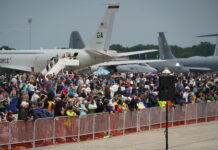As the 2014 air show season spools down, it is a common practice of mine to look back on the season and reflect on the work that the industry has put forth to promote safety. It is a useful exercise to review completed projects as a means of preparing for the next year. However, when considering the totality of work completed over the past six seasons, and the work still to do, a pattern emerges – one that reflects the ebb and flow of the safety culture in the air show business.
In 2007, for example, ICAS began a deliberate effort to transform the culture of air show safety. From the beginning, the organization acknowledged that a true culture change would not be accomplished quickly, but would require many incremental changes introduced continually over time. We saw improvements in 2008, and more in 2009. But it is only by looking back over the last seven years that we see the very real, quantifiable progress made since we set our collective focus on improving safety. And there is widespread agreement within the air show community that the initiative has worked well and for a sustained period of time.
Another example: By 2008, ICAS had already made much needed, common sense edits to the ACE Manual. Three years and dozens of meetings, phone calls and conferences later, the ICAS Board of Directors approved the proposed changes. Since that time, ICAS has completed another two revisions to the ACE Manual to streamline the system, improve safety and increase professionalism in the air show business.
Developing consensus and moving the program forward were more challenging than we would have liked. But the involvement of the entire air show community combined with the constant and dedicated attention of the ACE Committee and ICAS staff have made the final product even better than it would have been without those efforts. The current ACE program is vastly improved and more in line with the aviation industry than anyone would have thought it could be back in 2008.
In 2009, the industry began collecting emergency extraction information from performers for use by first responders to facilitate and expedite a rescue in the event of an air show accident. Five years later, we are still hard at work collecting that information from performers. But momentum for this project has significantly increased. In the past year alone, we have grown the database from six aircraft to nearly 30 with more coming in weekly. Much of this progress has come about as a result of air shows – EAA’s AirVenture, specifically – requiring that all performers submit their extraction information prior to flying at their events. Although we would like to have made greater progress, the truth is that our most meaningful and sustainable initiatives work best when they are implemented organically, when members participate as they begin to see the value of the exercise.
Where do we go from here? Experience tells us that the next important advances to be introduced to the ICAS safety program are changes about which you have already heard. Issues like improving air boss training, developing and refining best practices within the industry, and expanding performers’ ability to practice low-level aerobatics are all front runners for capturing the attention of the air show world and helping us realize our common goal: improving air show safety. Many of these initiatives have already begun and will only generate lasting results when essential preparatory work has been completed and members begin to “buy in.”
The Grand Canyon began when the Colorado River slowly and consistently carved the earth into the shape of one of the most magnificent wonders of the world. In life, nature and air show safety, we are best served by a slow, steady, consistent approach to improvement. Constant pressure evenly applied over a sustained period will always do more than sudden, brief bursts of energy. While it may seem tedious or monotonous to hear about the same programs and initiatives over months or even years, history tells us that these efforts will produce true and lasting change in our industry.








